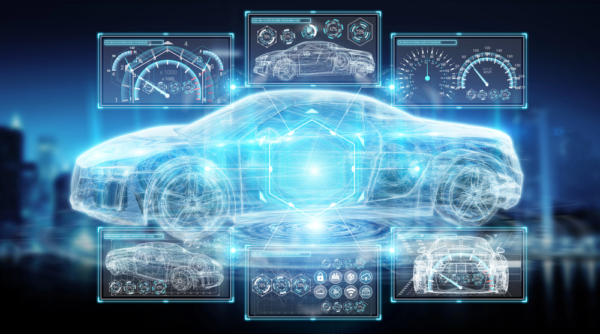
We’re inevitably heading to a future dominated by the autonomous vehicle, and marrying advanced tech with transportation presents unprecedented opportunities—and challenges. Autonomous cars promise to revolutionize human mobility, increase safety and efficiency, and even offer better and more equitable accessibility. But these vehicles are also reliant on complex digital systems and thus more vulnerable to cyber threats. That makes cybersecurity in autonomous vehicle a primary consideration in development.
Cybersecurity in Autonomous Vehicle Development
Why It’s Needed
These vehicles rely heavily on interconnected systems and make use of artificial intelligence (AI), machine learning algorithms, sensors, and communication networks to get the job done. They are also processing vast amounts of data quickly and making decisions that can have life-or-death consequences. In this environment, cyber threats can take many forms; all of them scary.
Hackers could potentially take control of a vehicle’s systems, for example, to deliberately cause accidents or use the vehicle for malicious purposes. Personal data collected by the vehicle could be stolen, and we could see enormous increases in privacy breaches. Disruptions in communication networks could keep these vehicles from being able to navigate safely. Serious cybersecurity measures are essential to protect the physical safety of passengers (and others around them) and the integrity of personal and operational data.
Complexity and Vulnerabilities
The complexity of these vehicle systems introduces multiple points of vulnerability for a hacker to take advantage of. For instance, sensors and cameras collect data from the vehicle’s environment; but if these inputs are manipulated, the vehicle could make dangerous and faulty decisions. The AI algorithms that process this data must be secured against tampering.
Connectivity is another significant vulnerability. Autonomous vehicles communicate with other vehicles (V2V communication), infrastructure (V2I communication), and cloud services. This connectivity enables features like traffic optimization and predictive maintenance; it also opens pathways for cyberattacks.
Regulations and Industry Standards
Regulations are being developed to ensure manufacturers develop and follow security best practices, and compliance with these regulations is important to any manufacturer who wants market access and consumer confidence. Manufacturers and developers must stay abreast of constantly evolving regulations and standards and integrate security considerations from the earliest stages of design and development.
Vendor-Agnostic Solutions for Comprehensive Security
Given the multifaceted nature of security needs in autonomous cars, a one-size-fits-all solution just won’t cut it. Our vendor-agnostic approach at SAABS RDS allows for the selection of the best technologies and solutions from multiple providers and thus offers flexibility that ensure every component of each of the vehicle’s system is secured using the most effective methods available.
Collaborating with various vendors also allows you to better integrate diverse technologies for a stronger and more resilient security framework. This approach also allows for scalability and adaptability: if you’re not being tied to a single vendor, you can incorporate cutting-edge solutions as they emerge.
Implementing Best Practices
Effective security has to address threats at every level. Key components of this approach include:
Secure Software Development
Security should be integrated into the software development lifecycle from the very beginning by employing coding practices that minimize vulnerabilities, conducting code reviews, and using tools that detect security flaws early in the development process.
Hardware Security Measures
The physical components of these vehicles, such as sensors, processors, and communication modules, must also be secured. This can be done using hardware that has built-in security features, implementing tamper-resistant designs, and/or ensuring that hardware components are sourced from reputable suppliers.
Encryption and Authentication Protocols
Strong encryption methods protect data both at rest and in transit. Strong, multi-layered authentication protocols ensure that only authorized people and entities can access the vehicle’s systems, which helps to prevent any compromise to vehicle control.
Network Security
Securing the communication networks that vehicles rely on is another important step. They must be protected against threats like man-in-the-middle attacks, denial-of-service attacks, and eavesdropping.
Regular Security Assessment
Regular security assessments, including penetration testing, vulnerability scanning, and security audits, will identify new vulnerabilities that may have emerged due to changes in the system or new threat vectors.
Incident Response Planning
Despite the best preventive measures, security incidents may still occur, so having a well-defined incident response plan means you’re able to respond quickly and effectively to contain a breach, minimize damage, and restore normal operations. This plan should include clear roles and responsibilities, communication strategies, and procedures for forensic analysis.
At SAAB RDS, we can provide the comprehensive support you need to implement and keep up with best practices. Our team works closely with you to develop customized security strategies that address your specific needs and challenges. We leverage our expertise across various technologies and vendors to deliver solutions that are both effective and adaptable to your needs.
SAAB RDS: Partnering for Secure Autonomous Mobility
Our unique technical expertise spans multiple technologies and vendors, and we’re positioned to provide comprehensive and customized solutions for those looking to integrate the digital world safely into their manufacturing. We believe that customer satisfaction comes first, and we are committed to working collaboratively to achieve your goals. By offering our services as Software as a Service (SaaS), we also provide flexibility and scalability, we make it possible for you to adapt quickly to new challenges and technological developments.
The world of digital transformation is exciting, but it’s only going to be profitable for those who are prepared to take on the challenges it presents. One of these challenges is ongoing security that ensures you access to the marketplace and trust for your brand. We can help. Visit SAABS RDS today to learn how we deliver cutting-edge solutions to today’s problems in automotive manufacturing.
